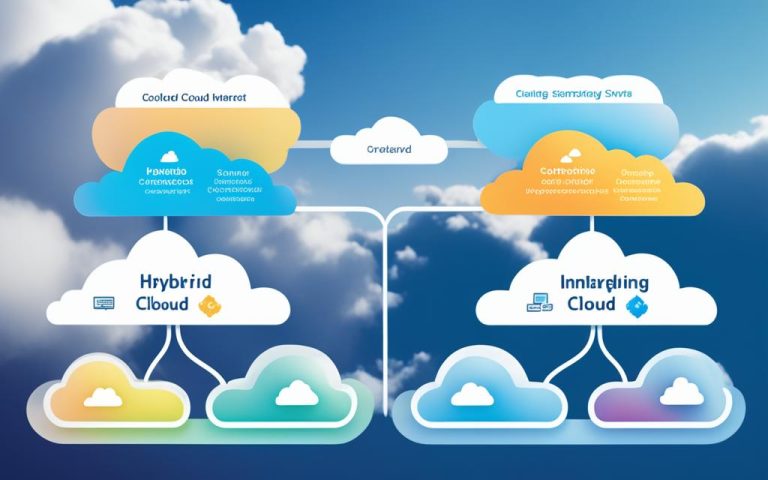In today’s digital landscape, businesses are increasingly relying on operating systems (OS) in cloud environments for their computing needs. The scalability of these OS plays a vital role in ensuring optimal performance, reliability, and cost-effectiveness.
OS scalability refers to the ability of a system to handle increasing or decreasing demand without compromising performance, reliability, or cost. In cloud environments, scalability can be achieved through virtualization, allowing businesses to scale resources and performance according to their needs. This flexibility ensures that organizations can efficiently manage their workloads, whether they experience peak hours or increased demand.
One of the key advantages of scalable cloud environments is their ability to adjust resources during peak hours and increased workloads. This ensures all-time availability and minimal service disruption, delivering a seamless user experience. Additionally, cloud providers have data centers across different regions, allowing organizations to deploy their applications and services closer to their target audience. This proximity ensures quick response times, low latency access, and a better user experience overall.
Scalability also plays a crucial role in disaster recovery and business continuity. Cloud environments offer distributed data centers and automated backups, ensuring quick recovery in case of any unforeseen events. By leveraging these features, businesses can rest assured that their data and services remain protected and accessible.
In conclusion, scalability features of operating systems in cloud environments are imperative for businesses aiming to optimize their performance and resource utilization. By embracing scalability, organizations can unlock the full potential of their cloud infrastructure, ensuring efficient operations and seamless user experiences.
Elasticity vs Scalability in Cloud Computing
Elasticity and scalability are two important features in cloud computing, although they have distinct differences.
Elasticity refers to a system’s ability to grow or shrink dynamically in response to changing workload demands, while scalability refers to the ability to increase workload with existing hardware resources.
“Elastic solutions are suitable for variable and unpredictable workloads, dynamically matching resources with demand in real-time.”
On the other hand, scalable solutions enable stable, longer-term growth in a pre-planned manner. The priority of elasticity or scalability depends on whether a business has predictable or highly variable workloads.
Comparing Elasticity and Scalability
| Elasticity | Scalability |
|---|---|
| Matches resources with real-time demand | Increases workload with existing resources |
| Ideal for variable and unpredictable workloads | Suitable for stable, longer-term growth |
| Dynamic scaling based on demand | Pre-planned growth strategy |
When considering cloud scalability, businesses need to assess whether elasticity or scalability is more appropriate for their specific workload characteristics and growth plans.
Horizontal vs Vertical Scaling in Cloud Systems
When scaling a cloud system, one of the first decisions to make is whether to use horizontal or vertical scaling. Both approaches have their advantages and considerations, and the choice depends on several factors such as workload, cost, availability, and performance requirements.
Horizontal Scaling
Horizontal scaling involves adding or removing more instances of the same type of resource, such as servers or databases. It is a popular method for expanding the capacity of stateless and distributed applications.
Horizontal scaling allows businesses to handle increased workload by distributing the load across multiple resources, enabling better load balancing and fault tolerance. This scalability approach is especially beneficial for applications with high traffic and demand fluctuations.
This scaling method utilizes load balancing techniques to evenly distribute incoming requests to the available resources, ensuring efficient resource utilization and avoiding bottlenecks. It also offers the advantage of fault tolerance by allowing one resource to take over if another fails.
Vertical Scaling
Vertical scaling involves increasing or decreasing the capacity of a single resource, such as CPU, memory, or disk space. This method is suitable for stateful and centralized applications that require consistent and fast access to data.
By vertically scaling resources, businesses can enhance the performance and capacity of individual components. It allows applications to handle increased demands by allocating more resources to the existing infrastructure.
Vertical scaling is often achieved by upgrading the hardware of a resource. For example, upgrading the CPU or adding more memory to a server. This method is particularly useful for applications that rely on single, powerful resources rather than distributing the workload across multiple instances.
Choosing the Right Scaling Strategy
Selecting the appropriate scaling strategy depends on the specific requirements and characteristics of the cloud system. Here is a comparison table that highlights the key considerations for horizontal and vertical scaling:
| Horizontal Scaling | Vertical Scaling |
|---|---|
| Allows for more efficient load balancing | Enhances the performance of individual resources |
| Provides fault tolerance and high availability | Ensures consistent and fast access to data |
| More suitable for stateless and distributed applications | More suitable for stateful and centralized applications |
| Allows for easier scaling out by adding more resources | Allows for scaling up by upgrading existing resources |
| Can be more cost-effective for handling variable workloads | Can be more cost-effective for stable workloads |
In summary, horizontal scaling is ideal for dynamic workloads, distributed applications, and increased fault tolerance. Vertical scaling, on the other hand, is beneficial for applications that require consistent access to data and centralization of resources. By understanding the characteristics of each scaling method, businesses can make informed decisions about scaling their cloud systems effectively.
Load Balancing and Caching for Scalability in Cloud Environments
Load balancing and caching are essential techniques for achieving scalability in cloud environments. By efficiently managing the distribution of requests and optimizing data storage, businesses can enhance the performance and reliability of their cloud systems. Let’s explore how load balancing and caching contribute to scalability in cloud environments:
Load Balancing
Load balancing involves distributing requests or tasks across multiple resources in a cloud environment. By evenly allocating workload based on availability, capacity, or location, load balancing ensures optimal resource utilization and prevents any single resource from being overwhelmed.
Implementing load balancing at different levels, such as network, application, or database, allows for effective resource allocation and improved performance. Various load balancing algorithms can be used, including round-robin, least connection, and weighted round-robin, among others.
With load balancing, businesses can effectively handle increasing workloads, scale resources as needed, and ensure high availability and minimal service disruption. It also enables efficient utilization of hardware resources, reducing costs and maximizing efficiency.
Caching
Caching involves storing frequently accessed or computed data in a faster or closer storage layer. By storing data closer to the users or applications, caching reduces latency and bandwidth consumption, resulting in improved performance and faster response times.
When data is requested, the cache is checked first to see if the data is already available. If it is, the system retrieves the data from the cache instead of fetching it from the backend resource, reducing the load on the backend and improving overall system efficiency.
Caching can be implemented at different levels, such as browser caching, CDN caching, or application-level caching. It improves scalability by reducing the load on backend resources and enhancing the user experience by providing faster access to frequently accessed data.
A Properly Designed and Implemented Load Balancing and Caching Solution Can:
- Improve performance and reduce response times
- Enhance reliability and minimize downtime
- Optimize resource utilization and reduce costs
- Scale efficiently to handle increasing workloads
- Ensure high availability and fault tolerance

| Load Balancing | Caching |
|---|---|
| Optimizes resource utilization | Reduces latency and bandwidth consumption |
| Prevents overloading of individual resources | Improves response times |
| Increases system reliability and availability | Enhances user experience |
| Ensures efficient scaling of resources | Minimizes load on backend resources |
| Reduces costs and maximizes efficiency | Optimizes data access and retrieval |
By leveraging load balancing and caching techniques, businesses can achieve scalability in their cloud environments and deliver high-performance, reliable, and cost-effective solutions.
Microservices and Serverless Architecture for Simplifying Scalability
When it comes to simplifying scalability in cloud systems, two popular approaches that organizations can leverage are microservices and serverless architecture. These methodologies offer unique advantages that enhance the scalability and efficiency of cloud systems, enabling businesses to meet the growing demands of their users.
Microservices: Faster Scaling, Testing, and Updating
Microservices are small, independent units of functionality that communicate with each other via APIs. This architecture breaks down complex applications into smaller, manageable components, each responsible for a specific task. By adopting microservices, businesses can achieve faster and easier scaling, testing, and updating of their cloud systems.
This approach allows organizations to scale individual microservices independently, allocating resources based on the specific needs of each component. As a result, organizations can optimize the allocation of resources, ensuring that critical functions have the necessary resources while avoiding resource wastage in less critical areas.
Moreover, microservices enable better isolation and fault tolerance. By decoupling application components, failures in one microservice do not affect the entire system, enhancing the system’s resilience. This also enables easier debugging and troubleshooting, as errors can be pinpointed to the specific microservice responsible.
Serverless Architecture: Efficient and Flexible Scaling
Serverless architecture, on the other hand, takes scalability to another level by abstracting away the underlying infrastructure management. In this model, the cloud provider takes care of the execution and provisioning of resources based on events or triggers. This allows businesses to focus on developing and deploying their applications without worrying about the operational overhead of managing servers and infrastructure.
The serverless model enables more efficient and flexible scaling. With serverless computing, organizations only pay for the precise amount of resources consumed during execution, providing cost optimization and reducing operational overhead. This allows organizations to scale their applications seamlessly in response to varying workloads, ensuring optimal performance and resource utilization.
Streamlining Development and Deployment
Both microservices and serverless architecture contribute to streamlining the development and deployment of cloud systems. Microservices allow teams to work collaboratively on specific components, improving productivity and reducing dependencies. The independent nature of microservices also facilitates the use of different programming languages and technologies, enabling teams to use the most suitable tools for each microservice.
Serverless architecture provides organizations with the ability to focus on business logic while the cloud provider manages the underlying infrastructure. This simplifies the deployment process, as organizations only need to package and deploy their application code, without worrying about provisioning servers or managing infrastructure. Additionally, serverless architectures promote rapid development and shorter time to market, enabling organizations to iterate and release new features or improvements quickly.
Overall, the combination of microservices and serverless architecture offers businesses a powerful toolkit for simplifying scalability in cloud systems. These approaches provide flexibility, efficiency, and enhanced resource utilization, allowing organizations to deliver high-performing applications and services.
| Microservices | Serverless Architecture |
|---|---|
| Small, independent units of functionality | Abstracts infrastructure management |
| Faster and easier scaling, testing, and updating | Optimized resource utilization and cost |
| Better isolation and fault tolerance | Efficient and flexible scaling |
| Streamlined development and deployment | Rapid development and shorter time to market |
Conclusion
Managing scalability in cloud environments is crucial for optimizing performance and resource utilization. Businesses can achieve this by implementing strategies such as load balancing, caching, and leveraging microservices and serverless architecture. These approaches enable organizations to scale their applications and services dynamically, ensuring optimal performance and meeting the needs of varying workloads in cloud environments.
Monitoring and automation play vital roles in measuring and controlling the performance and behavior of a cloud system. By continuously monitoring key metrics and automating processes, businesses can proactively identify and address scalability challenges, ensuring efficient resource allocation and mitigating any potential bottlenecks.
In addition to performance considerations, security and compliance are critical aspects of managing scalability in cloud environments. Organizations must implement robust security measures to protect data and resources, including encryption, access controls, and authentication mechanisms. Compliance with industry standards and regulations is also essential to ensure data privacy and meet legal requirements.
By effectively managing scalability, businesses can harness the full potential of OS scalability in cloud environments. This enables them to enhance overall efficiency, improve user experience, and drive business growth by leveraging the benefits of scalable infrastructure and flexible resource allocation.
FAQ
What is cloud scalability?
Cloud scalability refers to the ability of a system to handle increasing or decreasing demand without compromising performance, reliability, or cost. It allows businesses to scale resources and performance according to their needs by virtualization.
How does cloud scalability ensure high performance?
Cloud scalability ensures high performance by adjusting resources during peak hours and increased workloads, ensuring all-time availability and minimal service disruption. Cloud providers have data centers across different regions, allowing organizations to deploy their applications and services nearer to their target audience, ensuring quick response times, low latency access, and a better user experience.
What is the difference between elasticity and scalability in cloud computing?
Elasticity refers to a system’s ability to grow or shrink dynamically in response to changing workload demands, while scalability refers to the ability to increase workload with existing hardware resources. Elastic solutions are suitable for variable and unpredictable workloads, while scalable solutions enable stable, longer-term growth in a pre-planned manner.
What is the difference between horizontal and vertical scaling in cloud systems?
Horizontal scaling involves adding or removing more instances of the same type of resource, such as servers or databases, and is more suitable for stateless and distributed applications that can benefit from load balancing and fault tolerance. Vertical scaling involves increasing or decreasing the capacity of a single resource, such as CPU, memory, or disk space, and is more suitable for stateful and centralized applications that need consistent and fast access to data.
How does load balancing and caching help manage scalability in cloud environments?
Load balancing involves distributing requests or tasks to different resources based on criteria such as availability, capacity, or location, improving the overall performance and reliability of a cloud system. Caching involves storing frequently accessed or computed data in a faster or closer storage layer, reducing latency, bandwidth consumption, and load on backend resources.
What are microservices and serverless architecture?
Microservices are small, independent units of functionality that communicate via APIs, enabling faster and easier scaling, testing, and updating of a cloud system, as well as better isolation and fault tolerance. Serverless architecture is a model where the cloud provider manages the execution and provisioning of resources for a cloud system based on events or triggers, enabling more efficient and flexible scaling, lower operational overhead, and cost.
How can businesses manage scalability in cloud environments?
Businesses can manage scalability in cloud environments by implementing strategies such as load balancing, caching, and using microservices and serverless architecture. Monitoring and automation play important roles in measuring and controlling the performance and behavior of a cloud system. Security and compliance are also critical aspects to protect and regulate data and resources in scalable cloud environments.



















